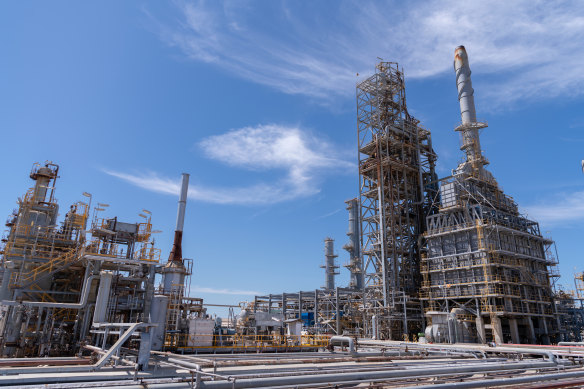By Nick Toscano
Global energy giant BP is pushing on with three ambitious renewable hydrogen projects in Australia and says it remains optimistic about the fuel’s future demand even as high costs and a lack of customers are forcing others to cancel local production plans.
The Albanese government is promising billions of dollars to turn Australia into a leading supplier of green hydrogen, a climate-friendly energy source that could substitute fossil fuels and help clean up heavy-polluting industries.

BP is repurposing the site of Kwinana oil refinery into a hub for clean energy.
But worries about the economics of locally made hydrogen are raising doubts about Australia’s potential: Origin Energy pulled out of a major hydrogen production venture in Newcastle earlier this month; Woodside recently withdrew an application for a project in Tasmania; and Andrew Forrest, one of hydrogen’s biggest advocates, paused Fortescue’s 2030 production targets, blaming the high cost and the vast amount of renewable energy needed to split hydrogen from water.
London-based energy major BP said it continued to believe hydrogen had a promising future as the world stepped up efforts to tackle global warming, and that it was continuing to back projects in Australia, Germany, Spain, the United States and Britain.
Hydrogen was expected to play a “crucial role” in decarbonising certain parts of the economy, such as heavy manufacturing or minerals processing, which were unable to simply switch from coal or gas to lower-carbon electricity, the company said. It might also one day be used as a vehicle for storing green energy, which could be loaded onto special ships and exported.
“BP is working hard to progress all three hydrogen projects that it is developing in Australia,” a spokesman said.
Most of the hydrogen produced in the world today for use in oil refining and fertilisers is limited to “grey hydrogen”, which is made from heating natural gas in a process that emits carbon dioxide. BP’s Australia projects focus on “green hydrogen”, which is produced when renewable energy is used to separate water into hydrogen and oxygen, making the result emissions-free.
However, green hydrogen costs much more to make than grey hydrogen and it is not yet commercially available at scale. In Australia and across the world, many projects have been stalling, unable to find enough customers because green hydrogen is too expensive and could prove challenging to transport.
One of BP’s projects is the Australian Renewable Energy Hub, a huge 26-gigawatt development spanning wind turbines, solar panels, green hydrogen and green ammonia, situated on 6500 square kilometres in Western Australia’s Pilbara.
It is also proposing 14 gigawatts of wind and solar at Geraldton to produce green hydrogen, as well as the H2Kwinana project, a hydrogen hub to be built at its former oil refinery in Perth, which closed in 2021.
Engineering work on the H2Kwinana hydrogen hub began last year, backed by $70 million of federal funding. It is also shortlisted for a share of the government’s “hydrogen head-start” funding, which includes a subsidy of $2 per kilogram for producers to help make the clean fuel cost-competitive. The government has also unveiled $6.7 billion in tax credits.
Given the challenges in advancing green hydrogen projects through early stages, BP said support from the government, access to renewable electricity, critical infrastructure and customers would be essential to building up an Australian industry.
Explosives maker Orica partnered with Origin Energy in 2022 to develop the $207 million Hunter Valley hydrogen hub, aiming to make hydrogen to replace feedstock gas in Orica’s Kooragang Island ammonia manufacturing plant.
Intended to launch production in 2026, the hub was among the most advanced hydrogen projects nationally and it had also been shortlisted under the government’s head start scheme, before Origin ultimately deemed it too risky to proceed to a final investment decision.
“It has become clear that the hydrogen market is developing more slowly than anticipated, and there remain risks and both input cost and technology advancements to overcome,” Origin chief Frank Calabria said.
Orica said it continued to believe in the “significant merit” of the project’s strategic location on the Port of Newcastle with access to an established end-market in its ammonia plant. Chief executive Sanjeev Gandhi said Orica was “open to discussions” with other parties.
Despite Fortescue putting on hold its target of producing 15 million tonnes of green hydrogen by 2030, it says it remains “steadfast” on commercialising the technology. Fortescue now plans to initially focus on four green hydrogen projects in Australia, the United States, Norway and Brazil. Further projects in Morocco, Oman, Egypt and Jordan would follow, the company said.
Energy Minister Chris Bowen said the federal government’s hydrogen incentives would unlock an estimated $50 billion of private investment. More than 50 companies are continuing to progress hydrogen investments in Australia.
“Government support in developing Australia’s hydrogen opportunity provides additional certainty for projects,” Bowen said. “However, how they progress remains a commercial decision for the parties involved.”
The Business Briefing newsletter delivers major stories, exclusive coverage and expert opinion. Sign up to get it every weekday morning.